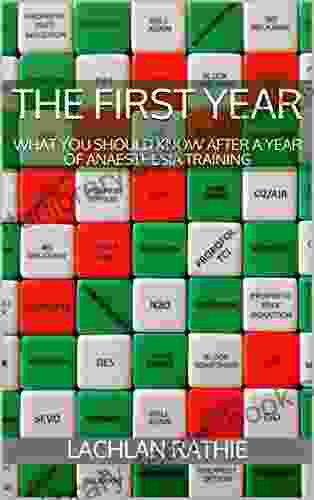What You Should Know After a Year of Anesthesia Training: A Comprehensive Guide for Aspiring Anesthesiologists


Anesthesia training is a demanding yet rewarding experience that prepares aspiring anesthesiologists for the challenges of providing safe and effective patient care in the operating room. After a year of training, residents gain a solid foundation in the principles and practice of anesthesia, making them eligible for further specialization in various subfields. This article provides a comprehensive overview of what you should know and expect after completing one year of anesthesia training.
5 out of 5
| Language | : | English |
| File size | : | 46724 KB |
| Text-to-Speech | : | Enabled |
| Screen Reader | : | Supported |
| Enhanced typesetting | : | Enabled |
| Print length | : | 310 pages |
| Lending | : | Enabled |
Core Competencies
By the end of the first year of anesthesia training, residents should have developed proficiency in the following core competencies:
- Patient Assessment and Evaluation: Ability to perform thorough pre-operative evaluations, identify potential risks, and develop individualized anesthesia plans.
- Induction and Maintenance of Anesthesia: Proficiency in inducing and maintaining anesthesia using various techniques, including general, regional, and local anesthesia.
- Airway Management: Expertise in securing and managing the airway, including endotracheal intubation, mask ventilation, and airway adjuncts.
- Monitoring and Vigilance: Ability to continuously monitor patients during surgery, interpret vital signs, and respond promptly to any changes in patient status.
- Pain Management: Understanding of pain physiology and principles of pain management, including pain assessment and multimodal analgesia techniques.
Clinical Rotations
During the first year of anesthesia training, residents typically rotate through various clinical services, including:
- Operating Room: Direct involvement in providing anesthesia for a wide range of surgical procedures.
- Critical Care Unit (ICU): Management of critically ill patients requiring mechanical ventilation and other advanced life support measures.
- Pain Management: Hands-on experience in performing regional nerve blocks and managing acute and chronic pain conditions.
- Obstetrics and Gynecology: Anesthesia for labor and delivery, cesarean sections, and gynecological procedures.
- Pediatrics: Anesthesia for pediatric patients, including neonates, infants, and children.
Didactic Education
In addition to clinical rotations, residents receive comprehensive didactic education in the following areas:
- Pharmacology: Detailed knowledge of anesthetic drugs, including their mechanisms of action, pharmacokinetics, and adverse effects.
- Physiology: In-depth understanding of cardiovascular, respiratory, and central nervous system physiology as it relates to anesthesia.
- Anesthesia Equipment: Mastery of anesthesia machines, monitors, and other essential equipment used in the operating room.
- Ethics and Legal Considerations: Education on ethical principles, patient safety, and legal liabilities in anesthesia practice.
- Research Methods: to research methods and statistical analysis for evaluating anesthesia outcomes.
Assessment and Evaluation
Residents' progress in anesthesia training is continuously assessed through a variety of methods, including:
- Clinical Performance Evaluations: Direct observation of residents' clinical skills and decision-making during surgical cases.
- Written and Oral Examinations: Regular exams to assess knowledge and understanding of anesthesia principles and practice.
- Simulation Training: Use of simulation mannequins and virtual reality environments to practice anesthesia techniques in a controlled setting.
- Case Log: Residents maintain a record of all anesthetic cases performed, including details of anesthetic management and patient outcomes.
Career Prospects
After completing one year of anesthesia training, residents are eligible to apply for a variety of fellowship programs in subspecialties such as:
- Cardiothoracic Anesthesia
- Neurosurgical Anesthesia
- Pediatric Anesthesia
- Obstetric Anesthesia
- Pain Medicine
Alternatively, residents may choose to enter private practice or academia as general anesthesiologists. The earning potential for anesthesiologists is typically high, with an average annual salary of over $300,000.
Personal and Professional Development
In addition to clinical and academic training, the first year of anesthesia residency is a time of significant personal and professional growth. Residents develop strong relationships with their mentors, peers, and patients, and learn the importance of teamwork and communication. They also gain a sense of autonomy and responsibility, and begin to develop their own anesthetic practice style.
The first year of anesthesia training is a transformative experience that lays the foundation for a successful career in anesthesia. By acquiring proficiency in core competencies, gaining broad clinical experience, and developing a strong academic base, residents emerge from this first year well-prepared to continue their specialization and contribute to the field of anesthesia.
5 out of 5
| Language | : | English |
| File size | : | 46724 KB |
| Text-to-Speech | : | Enabled |
| Screen Reader | : | Supported |
| Enhanced typesetting | : | Enabled |
| Print length | : | 310 pages |
| Lending | : | Enabled |
Do you want to contribute by writing guest posts on this blog?
Please contact us and send us a resume of previous articles that you have written.
 Novel
Novel Page
Page Chapter
Chapter Story
Story E-book
E-book Newspaper
Newspaper Bookmark
Bookmark Shelf
Shelf Glossary
Glossary Foreword
Foreword Footnote
Footnote Manuscript
Manuscript Scroll
Scroll Bestseller
Bestseller Library card
Library card Narrative
Narrative Biography
Biography Autobiography
Autobiography Reference
Reference Encyclopedia
Encyclopedia Dictionary
Dictionary Thesaurus
Thesaurus Narrator
Narrator Resolution
Resolution Librarian
Librarian Card Catalog
Card Catalog Stacks
Stacks Periodicals
Periodicals Study
Study Research
Research Reserve
Reserve Academic
Academic Interlibrary
Interlibrary Literacy
Literacy Study Group
Study Group Dissertation
Dissertation Storytelling
Storytelling Book Club
Book Club Theory
Theory Textbooks
Textbooks Charles Miller
Charles Miller Jamie Woodcock
Jamie Woodcock Mark Lareau
Mark Lareau A O Connor
A O Connor Thomas Borstelmann
Thomas Borstelmann Matthew Cordell
Matthew Cordell Lucille Lok Sun Ngan
Lucille Lok Sun Ngan Nikita Nain
Nikita Nain Geert Mak
Geert Mak Jerry A Mccoy
Jerry A Mccoy Conrad Bauer
Conrad Bauer Andy Jordan
Andy Jordan Samantha Hohnstadt
Samantha Hohnstadt Rianne Burnett
Rianne Burnett Philip Ciantar
Philip Ciantar Dinesh D Souza
Dinesh D Souza Sean Adams
Sean Adams Brooks Fiesinger
Brooks Fiesinger H D Walker
H D Walker Gerald Vizenor
Gerald Vizenor
Light bulbAdvertise smarter! Our strategic ad space ensures maximum exposure. Reserve your spot today!

 Terry BellUnveiling the Secrets of Overturned Heart Avenging Angels 12: A Comprehensive...
Terry BellUnveiling the Secrets of Overturned Heart Avenging Angels 12: A Comprehensive... Benjamin StoneFollow ·10.6k
Benjamin StoneFollow ·10.6k Jan MitchellFollow ·11.7k
Jan MitchellFollow ·11.7k Oliver FosterFollow ·4.1k
Oliver FosterFollow ·4.1k Walter SimmonsFollow ·10.6k
Walter SimmonsFollow ·10.6k Yukio MishimaFollow ·7.5k
Yukio MishimaFollow ·7.5k Edwin BlairFollow ·13.4k
Edwin BlairFollow ·13.4k Greg CoxFollow ·8.7k
Greg CoxFollow ·8.7k Thomas HardyFollow ·8.7k
Thomas HardyFollow ·8.7k

 Bo Cox
Bo CoxDiscover the Enchanting Allure of Collingwood, Ontario,...
Nestled amidst the breathtaking landscape of...

 Ralph Ellison
Ralph EllisonThe Street of Clocks Poems: A Poetic Journey Through Time
Welcome to The Street...

 Dwight Blair
Dwight BlairCritical Political Economy of the Middle East and North...
The Middle East and...

 Deion Simmons
Deion SimmonsPerfect Strategies For Painting Amazing Marine Creatures...
Gouache is a...

 Hugh Bell
Hugh BellThe American Republic: Constitution, Tendencies, and...
The American Republic,...
5 out of 5
| Language | : | English |
| File size | : | 46724 KB |
| Text-to-Speech | : | Enabled |
| Screen Reader | : | Supported |
| Enhanced typesetting | : | Enabled |
| Print length | : | 310 pages |
| Lending | : | Enabled |












